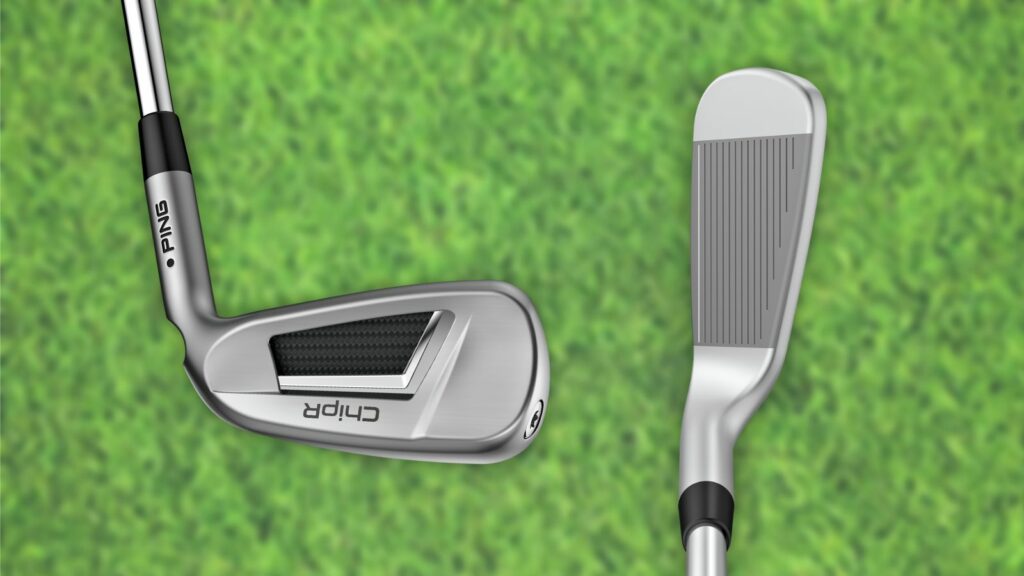For many amateur golfers, playing chip and pitch shots with a traditional wedge can cause numerous problems—most commonly chunks and skulls. Not only can this be frustrating and embarrassing, but it can also cause you to quickly rack up a big score.
Thankfully, a fairly recent club invention is here to end your chipping woes — the chipper.
In this article, I’ll discuss why chippers are frowned upon in golf, along with the pros and cons of using a chipper if you’re struggling around the greens. Stick around till the end of the article to find the 3 best chippers for amateur golfers.
Why Are Chippers Frowned Upon?
Chippers are frowned upon in golf because some say it’s a waste of a club, as you can’t hit full shots. Also, some argue that golfers should learn to chip with wedges, rather than take shortcuts. However, if a chipper makes your golf more enjoyable, don’t hesitate to use one!

What is a Chipper in Golf?
When chipping, the goal is to get the ball on the green and rolling toward the hole, like a putt. This requires a shot with minimal spin and a low trajectory.
To achieve this, many golfers use a lower lofted club like a pitching or gap wedge, or a short iron. However, wedges and irons can dig into the turf if you catch them heavy, or skull the ball if you strike them thin.
A chipper is a utility club—shaped like a hybrid between a wedge and a putter—designed for performing short chip shots to help you get the ball closer to the pin.
Chippers feature a wide sole and around 30-37 degrees of loft, similar to that of a 7 iron. So, the club is designed to make it easier to pop the ball onto the green when playing short bump-and-run chip shots.
Advantages of Chippers
There are several benefits of using a chipper when compared to a wedge or short iron:
- Shorter shaft length — Most chippers have a length of around 36 inches. This is similar to the length of a wedge but several inches shorter than a short or mid-iron, meaning you won’t have to grip down on the club when chipping.
- More upright lie angle — Chippers have a much more upright lie angle than wedges and short irons, typically between 68-70 degrees. This enables you to stand with your hands closer to the ball, taking a pendulum-like putting stroke.
- Heavier clubhead — Another benefit is the heavier clubhead, which also helps the pendulum effect of taking a putting-like motion. This encourages you to use your shoulders rather than your wrists, for a more consistent strike.
- Wider sole — Chippers tend to have a wider sole, designed to prevent the leading edge of the club from digging into the turf and causing fat shots.
- More forgiving — Most importantly, chippers are easy to hit. The combination of benefits listed above makes it easier for amateur golfers to make consistently solid contact, eliminating the problems that tend to come with chipping.
If you’re an amateur golfer who struggles with close-range chipping, these advantages are probably enough to convince you to consider adding one to the bag!
Disadvantages of Chippers
But while chippers have their advantages, there are some significant disadvantages that prevent the chipper from being a feature in every golfer’s bag:
- Limited shot type — With chippers, you are restricted to one type of chip: the bump-and-run. The design prevents you from opening the face in certain scenarios, as you would with a wedge. They don’t work out of bunkers or thick rough, and you’re essentially limited to using it just around the greens.
- Restricted distance — The other main disadvantage of chippers is that they can only be used for relatively short-range chip shots.
In a round of golf, you can only carry up to 14 clubs in your bag. Therefore, you would have to sacrifice a club for the chipper which might only be useful a handful of times.
Ultimately, this lack of versatility is the reason why chippers are sometimes frowned upon by your everyday golfer.
Nevertheless, a chipper can be an invaluable tool for a golfer in need of some help. In the video below, Matt Fisher puts a chipper to the test to see if it’s a club worth considering:
Are Chippers Legal?
Yes, chippers are legal clubs that conform to the rules of golf, provided that they have one clubface and are fitted with an iron grip, rather than a putter grip.
Two-sided wedges are not legal due to USGA Equipment Rule 4d, which states that “the clubhead must have only one striking face.”
Furthermore, chippers are regarded as iron clubs by the USGA. This means that they must be fitted with a typical iron grip, and “may not have a putter grip.”

Best Chippers For Amateur Golfers
If you’re sold on the benefits of chippers, it’s time to add one to the bag! Below, we’ve listed our top 3 chippers available today — for any budget.
Ping ChipR Wedge – Best Overall
Ping has been producing clubs since 1959 and has since become one of the leading manufacturers of golf equipment.
In 2022, Ping entered the chipper space with the Ping ChipR Wedge. The club is designed for golfers who lack confidence with a traditional wedge and struggle with chip shots. Usually, this comes as a result of inconsistent strikes, leading to hitting the ball fat or thin.
However, perhaps the best feature of this wedge is its aesthetics. The club is designed in a similar style to a typical wedge or iron. As a result, this chipper won’t look out of place alongside the other clubs in your bag.

Reasons to Buy
- Excellent, premium look
- Soft, forgiving feel
Reasons to Avoid
- Fairly expensive option
Rating: ★★★★★
>> You can order your Ping ChipR Wedge here
Wilson Harmonized Chipper – Best Value
Although not regarded as a premium brand in golf, Wilson has been manufacturing golf clubs and equipment since 1914.
The Wilson Harmonized Chipper is our best pick for golfers shopping on a budget. The classic design offers a fairly strong loft of 32 degrees, equal to that of a 7 iron. So, this chipper is a solid option for golfers who are looking to get the ball rolling over longer distances. Shorter chip shots, however, might take more practice.

Reasons to Buy
- Classic, simple design
- Works great from tight lies
Reasons to Avoid
- Strong loft better suited for longer chips
Rating: ★★★★☆
>> You can order your Wilson Harmonized Chipper here
Odyssey X-Act Chipper – Best Premium
Owned by Callaway, Odyssey has been responsible for some of the best putters in the world since they started making clubs in 1997.
While the Ping ChipR is one of the best premium chippers, the Odyssey X-Act Chipper is an excellent challenger. Engineered like an “Approach Putter”, the club sits between a putter and a wedge for shots around the green.
The clubhead features a hybrid-like sole, which improves turf interaction, especially on tight fairway lies. In addition, alignment guides help dial in your accuracy.

Reasons to Buy
- Forgiving sole
- Useful alignment guides
Reasons to Avoid
- Can be hard to master distance control
Rating: ★★★★★
>> You can order your Odyssey X-Act Chipper here
Final Thoughts – Should You Use a Chipper?
You should consider using a chipper if you’re particularly struggling around the greens.
Chippers provide consistency for shorter bump-and-run shots. So, you should consider one if you can afford to carry it as one of your 14 clubs.
However, it’s worth considering taking some lessons on how to use wedges if you have the time to practice. Wedges are versatile and can also be used out of thick rough, bunkers, and for longer shots into the green.
Ultimately, you shouldn’t care whether chippers are frowned upon in golf.
What’s important is your enjoyment of the game. The best way to achieve that is by lowering your score — by whatever means necessary!


